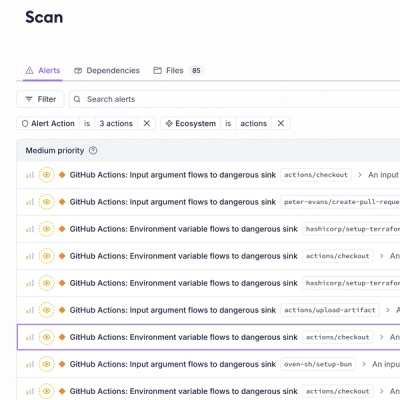
Product
Introducing Socket Firewall Enterprise: Flexible, Configurable Protection for Modern Package Ecosystems
Socket Firewall Enterprise is now available with flexible deployment, configurable policies, and expanded language support.
@postman/form-data
Advanced tools
A library to create readable "multipart/form-data" streams. Can be used to submit forms and file uploads to other web applications.

A library to create readable "multipart/form-data" streams. Can be used to submit forms and file uploads to other web applications.
The API of this library is inspired by the XMLHttpRequest-2 FormData Interface.
npm install --save form-data
In this example we are constructing a form with 3 fields that contain a string, a buffer and a file stream.
var FormData = require('form-data');
var fs = require('fs');
var form = new FormData();
form.append('my_field', 'my value');
form.append('my_buffer', new Buffer(10));
form.append('my_file', fs.createReadStream('/foo/bar.jpg'));
Also you can use http-response stream:
var FormData = require('form-data');
var http = require('http');
var form = new FormData();
http.request('http://nodejs.org/images/logo.png', function(response) {
form.append('my_field', 'my value');
form.append('my_buffer', new Buffer(10));
form.append('my_logo', response);
});
Or @mikeal's request stream:
var FormData = require('form-data');
var request = require('request');
var form = new FormData();
form.append('my_field', 'my value');
form.append('my_buffer', new Buffer(10));
form.append('my_logo', request('http://nodejs.org/images/logo.png'));
In order to submit this form to a web application, call submit(url, [callback]) method:
form.submit('http://example.org/', function(err, res) {
// res – response object (http.IncomingMessage) //
res.resume();
});
For more advanced request manipulations submit() method returns http.ClientRequest object, or you can choose from one of the alternative submission methods.
You can provide custom options, such as maxDataSize:
var FormData = require('form-data');
var form = new FormData({ maxDataSize: 20971520 });
form.append('my_field', 'my value');
form.append('my_buffer', /* something big */);
List of available options could be found in combined-stream
You can use node's http client interface:
var http = require('http');
var request = http.request({
method: 'post',
host: 'example.org',
path: '/upload',
headers: form.getHeaders()
});
form.pipe(request);
request.on('response', function(res) {
console.log(res.statusCode);
});
Or if you would prefer the 'Content-Length' header to be set for you:
form.submit('example.org/upload', function(err, res) {
console.log(res.statusCode);
});
To use custom headers and pre-known length in parts:
var CRLF = '\r\n';
var form = new FormData();
var options = {
header: CRLF + '--' + form.getBoundary() + CRLF + 'X-Custom-Header: 123' + CRLF + CRLF,
knownLength: 1
};
form.append('my_buffer', buffer, options);
form.submit('http://example.com/', function(err, res) {
if (err) throw err;
console.log('Done');
});
Form-Data can recognize and fetch all the required information from common types of streams (fs.readStream, http.response and mikeal's request), for some other types of streams you'd need to provide "file"-related information manually:
someModule.stream(function(err, stdout, stderr) {
if (err) throw err;
var form = new FormData();
form.append('file', stdout, {
filename: 'unicycle.jpg', // ... or:
filepath: 'photos/toys/unicycle.jpg',
contentType: 'image/jpeg',
knownLength: 19806
});
form.submit('http://example.com/', function(err, res) {
if (err) throw err;
console.log('Done');
});
});
The filepath property overrides filename and may contain a relative path. This is typically used when uploading multiple files from a directory.
For edge cases, like POST request to URL with query string or to pass HTTP auth credentials, object can be passed to form.submit() as first parameter:
form.submit({
host: 'example.com',
path: '/probably.php?extra=params',
auth: 'username:password'
}, function(err, res) {
console.log(res.statusCode);
});
In case you need to also send custom HTTP headers with the POST request, you can use the headers key in first parameter of form.submit():
form.submit({
host: 'example.com',
path: '/surelynot.php',
headers: {'x-test-header': 'test-header-value'}
}, function(err, res) {
console.log(res.statusCode);
});
Append data to the form. You can submit about any format (string, integer, boolean, buffer, etc.). However, Arrays are not supported and need to be turned into strings by the user.
var form = new FormData();
form.append( 'my_string', 'my value' );
form.append( 'my_integer', 1 );
form.append( 'my_boolean', true );
form.append( 'my_buffer', new Buffer(10) );
form.append( 'my_array_as_json', JSON.stringify( ['bird','cute'] ) )
You may provide a string for options, or an object.
// Set filename by providing a string for options
form.append( 'my_file', fs.createReadStream('/foo/bar.jpg'), 'bar.jpg' );
// provide an object.
form.append( 'my_file', fs.createReadStream('/foo/bar.jpg'), {filename: 'bar.jpg', contentType: 'image/jpeg', knownLength: 19806} );
This method adds the correct content-type header to the provided array of userHeaders.
Return the boundary of the formData. A boundary consists of 26 - followed by 24 numbers
for example:
--------------------------515890814546601021194782
Note: The boundary must be unique and may not appear in the data.
Return the full formdata request package, as a Buffer. You can insert this Buffer in e.g. Axios to send multipart data.
var form = new FormData();
form.append( 'my_buffer', Buffer.from([0x4a,0x42,0x20,0x52,0x6f,0x63,0x6b,0x73]) );
form.append( 'my_file', fs.readFileSync('/foo/bar.jpg') );
axios.post( 'https://example.com/path/to/api',
form.getBuffer(),
form.getHeaders()
)
Note: Because the output is of type Buffer, you can only append types that are accepted by Buffer: string, Buffer, ArrayBuffer, Array, or Array-like Object. A ReadStream for example will result in an error.
Same as getLength but synchronous.
Note: getLengthSync doesn't calculate streams length.
Returns the Content-Length async. The callback is used to handle errors and continue once the length has been calculated
this.getLength(function(err, length) {
if (err) {
this._error(err);
return;
}
// add content length
request.setHeader('Content-Length', length);
...
}.bind(this));
Checks if the length of added values is known.
Submit the form to a web application.
var form = new FormData();
form.append( 'my_string', 'Hello World' );
form.submit( 'http://example.com/', function(err, res) {
// res – response object (http.IncomingMessage) //
res.resume();
} );
Returns the form data as a string. Don't use this if you are sending files or buffers, use getBuffer() instead.
Form submission using request:
var formData = {
my_field: 'my_value',
my_file: fs.createReadStream(__dirname + '/unicycle.jpg'),
};
request.post({url:'http://service.com/upload', formData: formData}, function(err, httpResponse, body) {
if (err) {
return console.error('upload failed:', err);
}
console.log('Upload successful! Server responded with:', body);
});
For more details see request readme.
You can also submit a form using node-fetch:
var form = new FormData();
form.append('a', 1);
fetch('http://example.com', { method: 'POST', body: form })
.then(function(res) {
return res.json();
}).then(function(json) {
console.log(json);
});
In Node.js you can post a file using axios:
const form = new FormData();
const stream = fs.createReadStream(PATH_TO_FILE);
form.append('image', stream);
// In Node.js environment you need to set boundary in the header field 'Content-Type' by calling method `getHeaders`
const formHeaders = form.getHeaders();
axios.post('http://example.com', form, {
headers: {
...formHeaders,
},
})
.then(response => response)
.catch(error => error)
getLengthSync() method DOESN'T calculate length for streams, use knownLength options as workaround.2.x FormData has dropped support for node@0.10.x.3.x FormData has dropped support for node@4.x.Form-Data is released under the MIT license.
FAQs
A library to create readable "multipart/form-data" streams. Can be used to submit forms and file uploads to other web applications.
We found that @postman/form-data demonstrated a not healthy version release cadence and project activity because the last version was released a year ago. It has 154 open source maintainers collaborating on the project.
Did you know?

Socket for GitHub automatically highlights issues in each pull request and monitors the health of all your open source dependencies. Discover the contents of your packages and block harmful activity before you install or update your dependencies.

Product
Socket Firewall Enterprise is now available with flexible deployment, configurable policies, and expanded language support.

Security News
Open source dashboard CNAPulse tracks CVE Numbering Authorities’ publishing activity, highlighting trends and transparency across the CVE ecosystem.

Product
Detect malware, unsafe data flows, and license issues in GitHub Actions with Socket’s new workflow scanning support.